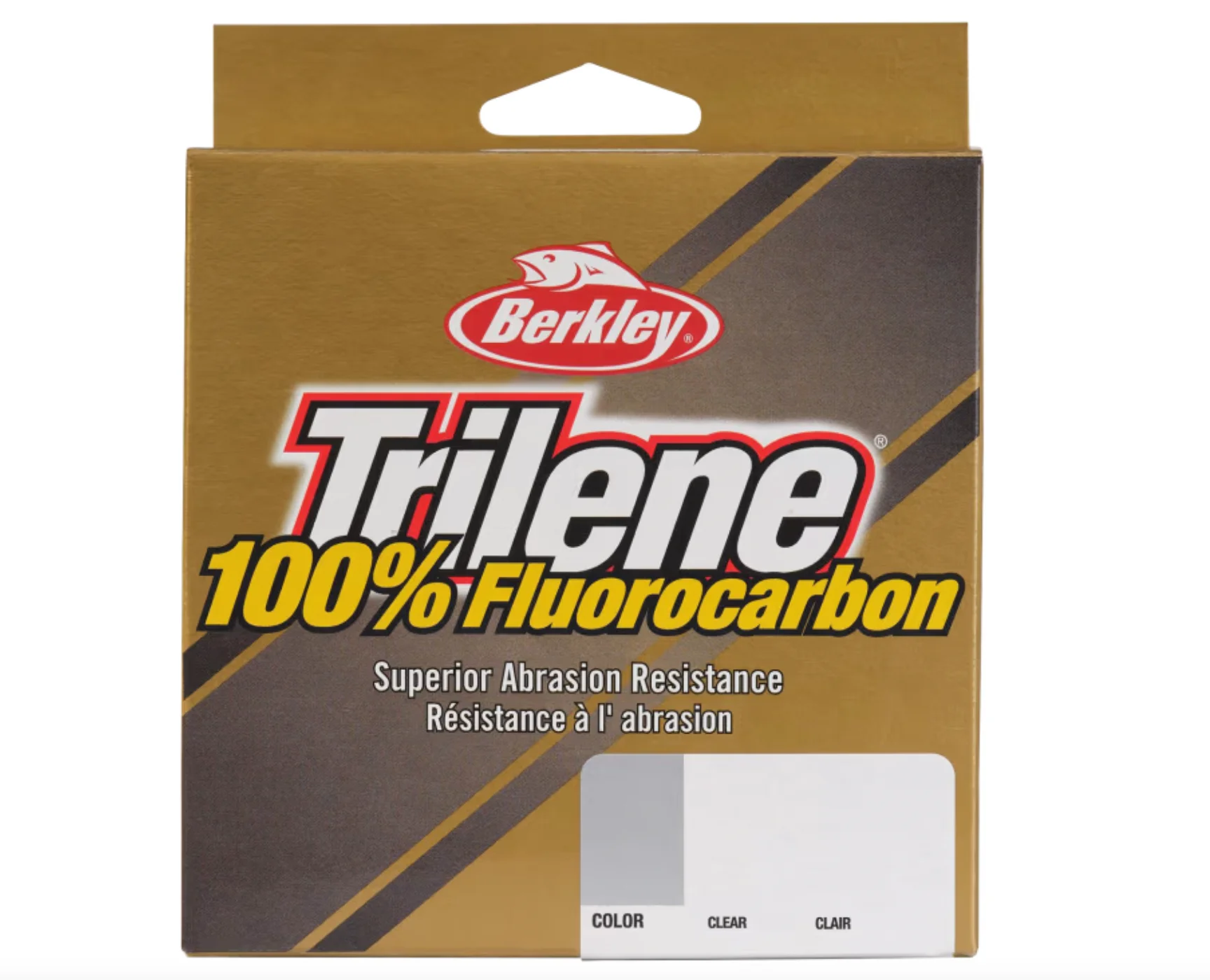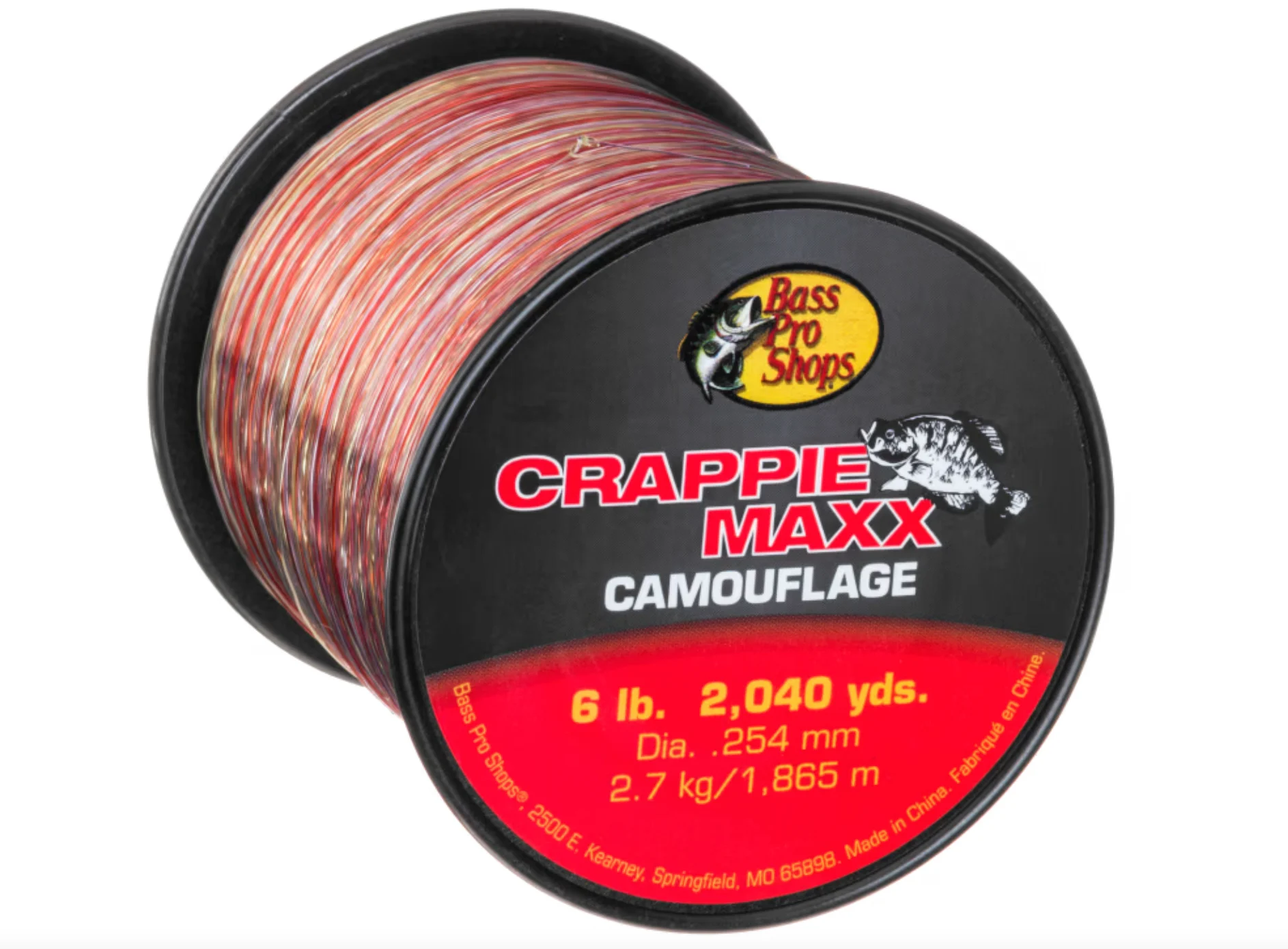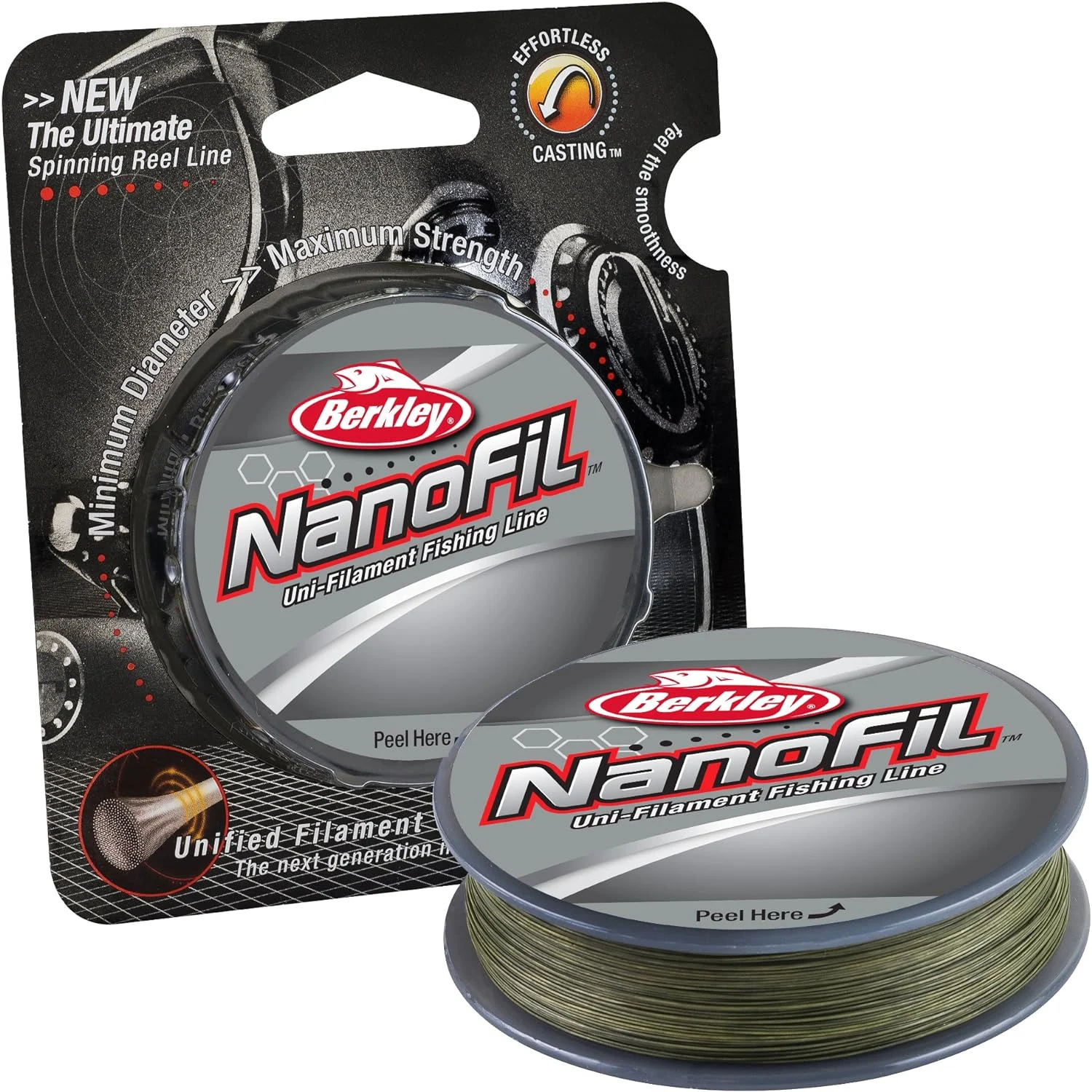We may earn revenue from the products available on this page and participate in affiliate programs. Learn more ›
With all the recent fuss over fancy electronics and fishing accessories mounted to the front of the boat, the most critical link between the angler and fish is still the fishing line. It hasn’t seen the same marketing hype and attention as other components of a modern fishing trip, but fishing lines have quietly undergone a revolution in technology. You’ve seen a transition from stretchy, easily damaged nylons to advanced formulas of denser fluorocarbon and even the same dyneema fibers found in bulletproof vests.
Here are a few of the best fishing lines for crappie to spool onto your reel. Whether you prefer sitting on the bank watching a cork and minnow rig or teasing them into biting with live-sonar and best crappie lures dangled in deep brush.
Best Braided: Berkley Nanofil
Best Monofilament: P-Line CXX X-tra Strong Copolymer
Best Fluorocarbon: Berkley Trilene 100% Fluorocarbon
Best Value: Bass Pro Shops Crappie Maxx Monofilament
How We Picked The Best Fishing Lines for Crappie
In addition to more than three decades of fishing for bass, crappie, catfish and other freshwater sportfish, I have had the opportunity to work with manufacturers and sales representatives of various tackle companies as well as dozens of fishing guides in fishing reports and product sales throughout the Central United States. Personal experience with a variety of lines, comparison of current line specifications, and regular conversations with experts in both construction and use of the many product options available guided these choices.
The Best Fishing Lines for Crappie: Reviews and Recommendations
Best Braided: Berkley Nanofil
Specs
Pound Test Ratings: 6, 12, 14, 17
Capacity: 150-yard spools available
Colors: Lo-Vis Green, Clear Mist, Hi-Vis Yellow
Pros
Smooth finish increases casting distance
Zero stretch creates maximum sensitivity
Color options offer versatility for many angler preferences
Cons
Slick finish does not work well with common knots
High buoyancy can create bow in line under the surface when cast
Many crappie anglers who employ a single pole to dangle a jig near stumps and other prospective cover have adopted braided lines for their strength and incredible feel. Berkley Nanofil is technically considered a uni-filament, meaning only one strand is present instead of multiple strands braided together. However, its properties are so similar to braids, it often is lumped in with them into a category called “superlines.” Nanofil line is treated with a special coating that makes its surface incredibly smooth. This smoothness offers anglers casting small lures on spinning rods some additional distance on each cast. It also flows smoothly through rod guides on the retrieve, preventing the line from cutting into the rod guides, a problem with some coarser braids.
The only drawback to Nanofil’s slick nature is that it does not work well with a simple clinch knot or loop knot. While this is the number one line I reach for on my jigging pole and spinning reel, a 4-foot length of fluorocarbon often is tied on as a leader, which allows me to fish my favorite knots and still enjoy all the benefits of braid. This line isn’t as limp as some true braids, which might lead to a loss of lure action if the leader weren’t employed. The clear mist color is a personal favorite, as it can be seen easily above the water but isn’t quite as overpowering as the hi-vis yellow option.
Best Monofilament: P-Line CXX X-tra Strong Copolymer
Specs
Pound Test Ratings: 4, 6, 8, 10, 12, 15, 17, 20
Capacity: 300-yard spools available as well as bulk spools ranging from 370- to 600-yards
Colors: Clear, Fluorescent Green, Smoke Blue, Moss Green, Hi-Vis Fluorescent
Pros
Extremely durable for fishing in heavy cover
Multiple colors and sizes available
Holds knots well and resists line burn
Cons
Can retain kinks if line loops form
Line twist can be an issue
An abrasion-resistant coating over the monofilament core makes P-Line extremely durable for anglers who probe jigs around cypress knees, stumps and other heavy cover. It’s also one of the best options for fishing around rocks and docks. CXX X-tra Strong outperforms fluorocarbons, braids and most other monofilaments when dragged along the sharp hard edges of riprap, sunken concrete structures and other hard cover. Relatively low stretch offers good sensitivity for light strikes, and it’s offered in a variety of colors to make watching for the line to jump or move easy on anglers’ eyes. Anglers who enjoy fishing under blacklights at night will even find two fluorescent options that will glow like a laser beam when illuminated with UV light when the sun goes down.
Best Fluorocarbon: Berkley Trilene 100% Fluorocarbon
Specs
Pound Test Ratings: 4, 6, 8, 10, 12, 15, 17, 20, 25
Capacity: 110-, 200-, and 2,000-yard spools available
Colors: Clear
Pros
Virtually invisible underwater
Low stretch for sensitivity
Sinks in water for more direct connection
Manageable on spinning reels
Cons
Prone to fraying if stressed
Hard to see above the water to detect strikes
Berkley Trilene Fluorocarbon fishing line is the top option for anglers looking to stay in direct contact with their jig from the time it touches the surface to the moment the fish engulfs the lure. While not quite as sensitive as braided fishing line, Trilene Fluorocarbon offers fantastic feel and carries the added bonus of being much less fussy when it comes to the type of knot you use. This line holds a standard clinch knot or loop knot many crappie anglers prefer without the need for a leader. In fact, this is the line many anglers use as their leader material when using a braided main line. In many years of fishing, I’ve found this brand to be much less prone to kinks and loops at the reel than other fluorocarbon lines.
As with all fluorocarbon lines Trilene 100% Fluorocarbon is dense enough to sink with the lure, which prevents slack in the line and lets you detect more strikes on the initial drop and pause of the lure. The only drawbacks to the line are that it’s very hard to see above the water to help detect strikes and that it does need replacement a bit more often than other line types. It should be inspected for wear a bit more often than monofilament of the same diameter, but this is true of all fluorocarbon lines. While this offering is a bit more expensive than basic monofilament offerings, it’s still extremely affordable and is one of the best fluorocarbon fishing lines, regardless of the species being pursued.
Best Value: Bass Pro Shops Crappie Maxx Monofilament
Specs
Pound Test Ratings: 4, 6, 8, 10
Capacity: 1,420- through 3,190-yard spools, depending upon line size
Colors: Camouflage, Hi-Vis Camo, Super-Vis Yellow
Pros:
Inexpensive
All color options easy to see to detect strikes
Manageable on spinning reels
Cons:
High stretch ratio lowers sensitivity
Susceptible to line twist
Crappie guides and anglers who fish many rods at once often can’t afford to spool up all of their rigs with expensive braids or fluorocarbon lines. That doesn’t mean they want to sacrifice performance or results for themselves or their clients. Crappie Maxx fishing line is a perfect solution for anglers setting multiple lines dressed with a bobber and minnow or pushing four jig-and-minnow rigs from the front of a boat equipped for spider-rigging
. It is a bit stretchy, so it doesn’t transmit the thump of a crappie taking a jig quite as well as braids and fluorocarbon lines, but the high-visibility of the line definitely aids in the angler seeing the strike above water and being able to react quickly. The camouflage color options also allow anglers who are worried about line-shy fish to tie their lures to a section of the line that is less visible while still being able to see higher-visibility sections of the line above the water. The line is a bit prone to line twist if used to constantly cast and retrieve. If you begin to see loops form, you should address them quickly to prevent a mess. Anglers who troll, vertical jig or suspend shiners from a slip-cork won’t see many issues with line twist as you’re spending more time with the bait in the strike zone and less time chunking and winding.
Things to Consider when Buying Fishing Line for Crappie
Anglers have been catching crappie with basic monofilament line for decades. But advances in materials and technology have increased the knowledgeable angler’s chances to put more fish in the boat and less time fussing with equipment. Here are a few things to remember when choosing a new spool of line from all the options on the sales rack.
Material
Crappie line comes in three primary categories: Nylon monofilament, braid, and fluorocarbon. Each with its own applications and time to shine on a crappie angler’s boat.
Nylon monofilament: The standard line your father and grandfather likely had on their reel when they introduced you to fishing. Once the cutting edge of fishing, monofilament is derived by heating nylon plastic pellets and pulling them through a die of a precise size to create one solid-cored line. Adjustments in the exact chemical makeup of the nylon used creates lines with different characteristics, but different formulas have trade offs. More supple lines may offer excellent handling on a fishing reel, but they tend to have more stretch and less sensitivity. Lines with less stretch can be on the stiff side and more prone to line twist and loops in the reel.
Fluorocarbon: Technically still monofilament because they are a single solid-cored strand of line, but instead of nylon, manufacturers use polyvinylidene fluoride. This material is much denser than nylon, which translates into a finished product that has much less stretch and higher sensitivity than nylon lines. These lines are more expensive than mono, but the best fluorocarbon lines reflect light less than nylon monofilaments, so they are harder to see in the water.
Braided lines: Manufactured using high molecular weight polyethylene. Brand names like Spectra and Dyneema are commonly used by manufacturers, but all these lines essentially are made from the same base materials. Unlike the singular, solid construction of monofilament and fluorocarbon lines, braided lines are composed of multiple strands of these fibers that have more tensile strength than steel. This strength enables manufacturers to create lines that are much thinner than mono and fluorocarbon for each “pound test” strength rating. The construction also offers near zero stretch, which translates into extreme sensitivity. Crappie anglers should use some caution when setting the hook on a fish when using braid, however. Without some stretch in the line, the hook can tear through the thin membrane of a crappie’s mouth, allowing it to pull free.
Fishing Technique
Panfish angling can be as simple as fishing with a live shiner under a clip-on plastic bobber, or it can be as intricate as running multiple rods from rod holders or scanning the depths with sonar and presenting a tube jig right on their nose until they decide to bite. Basic monofilaments are fine for live bait and trolling techniques. In fact, many guides still spool up with mono because it saves a lot of money when rigging dozens of rods for clients to use. But, when anglers are running a single jigging pole or spinning rod to tease panfish out of stumps and other heavy cover, the sensitivity of braids and fluorocarbons is worth dropping a few extra dollars.
FAQs
Q: What size line should I use for crappie fishing?
In general, you’ll never go wrong spooling up 6- or 8-pound test diameter line when chasing black or white crappie, but there are some situations that may call for other fishing lines. If the water is exceptionally clear or fish have seen a lot of pressure, then downsizing to 4-pound test can increase catch rates when fishing small jigs and artificials. The lighter line offers less profile, but it also tends to be more limp, which translates into a slightly more lively action. However, if you find yourself fishing weed edges or heavy cover in stained water, stepping up to 10-pound test and even 12-pound test may be necessary to get the fish out of the salad. Snags are a fact of life if you’re fishing in the right place. A steady pull with heavier line often can straighten light-wire hooks used for crappie fishing, letting you bend them back and get to fishing quicker than losing a jig and retying.
Q: Can crappie see hi-vis line?
The question of whether crappie can see high-visibility lines really should be “Do they care about hi-vis line?” When trolling, casting and otherwise using fast-moving lures, the fish is striking out of reaction, so visibility is much less of a concern. Additionally, when anglers are using live shiners in rigs like the ones featured in our article on the Best Live Bait Crappie Rigs the temptation of live bait will override any negative aspect of the fishing line color. Vertically jigging or slowly crawling a tube jig or grub are really the only two areas where the color might matter. Even then, line size will play a much more critical role in visibility than color. The smaller the line diameter, the less visible it will be and the more lifelike your presentation will appear, focusing the attention on the lure. The angler’s ability to see the line twitch or jump when a light strike occurs is much more critical to success on tough days, which is why hi-vis line is so popular.
Some anglers swear to higher catch rates when using nearly invisible fluorocarbon lines when conditions are tough, but it may be a self-fulfilling prophecy. Confidence in your equipment causes you to stay a little longer and pay a little more attention on a tough day. Until we meet a crappie that talks, we’ll never know for sure if they care about line color. For anglers who still want the safety net of clear lines, a reel spooled with hi-vis matched with a 4-foot leader of lightweight premium fluorocarbon offers the best of both worlds.
Final Thoughts on the Best Fishing Lines for Crappie
All of the lines mentioned in this article were chosen specifically for their ability to perform with standard fishing techniques used for crappie. Bream and other panfish may call for lighter line sizes, but these same brands will perform in those applications as well. If you want something more generally applicable, click here for a list of lines that covers a broader range of species.
Why Trust Us
For more than 125 years, Field & Stream has been providing readers with honest and authentic coverage of outdoor gear. Our writers and editors eat, sleep, and breathe the outdoors, and that passion comes through in our product reviews. You can count on F&S to keep you up to date on the best new gear. And when we write about a product—whether it’s a bass lure or a backpack—we cover the good and the bad, so you know exactly what to expect before you decide to make a purchase.









